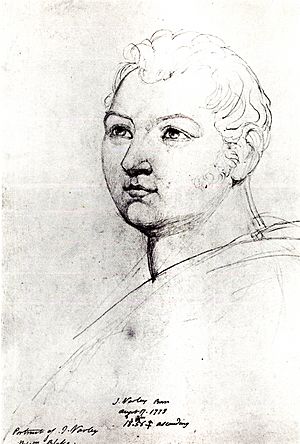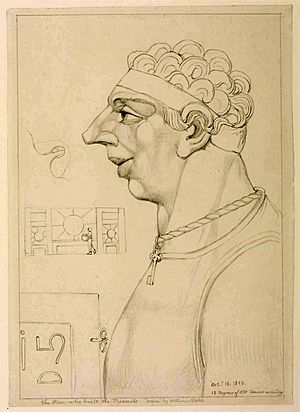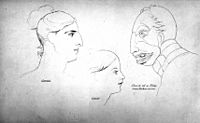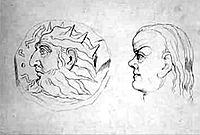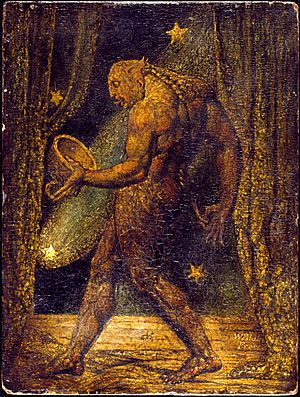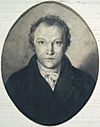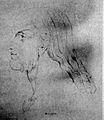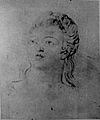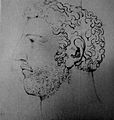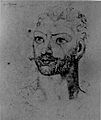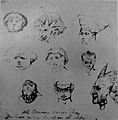Visionary Heads facts for kids
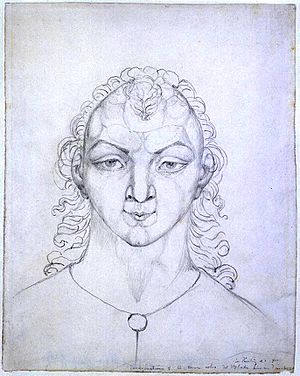
The Visionary Heads are a collection of drawings made by the famous artist William Blake. He created them after 1818 at the request of John Varley, who was a watercolour artist and also studied astrology.
The people and characters in these drawings, many of whom are well-known figures from history or myths, appeared to Blake in his visions. It was as if they were sitting right in front of him for a portrait! These drawings are found in three special sketchbooks, and there are also some loose pages that suggest there might have been a fourth sketchbook.
Some of the famous people Blake drew in his Visionary Heads include David, Solomon, Socrates, Julius Caesar, Christ, Muhammad, Merlin, Boadicea, Charlemagne, Robin Hood, and even the Devil and Satan. One of the most famous drawings from this series is The Ghost of a Flea.
Contents
How the Visionary Heads Were Made
William Blake often said he saw visions throughout his life, starting from when he was very young. He believed that spirits of people from the past, and even his friends who had passed away, would visit him. He felt these spirits gave him ideas for his poems and paintings. He even thought that archangels encouraged him to create his art and enjoyed looking at it! In 1800, he wrote that his deceased friends were "more really with us than when they were apparent to our mortal part."
In 1818, a successful young painter named John Linnell, who was a good friend of Blake's, introduced Blake to his old teacher, John Varley. Varley was fascinated by Blake's stories of his visions. He thought these visions came from the spirit world, connected to astrology. Varley convinced Blake to draw these visions while he was there. He wanted to use these drawings in his own book, Treatise on Zodiacal Physiognomy, which was published after Blake passed away.
From 1819 to 1820, Blake and Varley often met at Varley's house. They would play a game where Varley would ask Blake to try and call up the spirit of a famous historical or mythical person. When Blake said he saw the spirit, he would then try to sketch what it looked like. Many of these drawings still exist today.
Blake's biographer, Alexander Gilchrist, described these meetings. Varley would ask Blake to draw someone like "Moses" or "Julius Caesar." Blake would then say, "There he is!" and start drawing right away, looking up as if a real person was sitting in front of him. Varley, meanwhile, would stare into empty space, trying hard to see something, but he never did.
Sometimes, Blake had to wait for a vision to appear. Other times, he would suddenly stop drawing and say, "I can't go on, it is gone! I must wait till it returns." Or he might say, "It has moved. The mouth is gone," or "He frowns; he is displeased with my portrait of him." It was as if the vision was watching Blake draw! Even the devil himself would politely sit for Blake and then disappear.
These drawing sessions sometimes became public events. Many people heard about them, and several exciting stories were published. These stories usually agreed with each other and with the notes written on the drawings themselves.
John Varley kept detailed notes about these almost nightly sessions. He wrote down dates and details on or behind Blake's drawings, which helps us understand them today. He also made two lists, known as "Varley's lists of Visionary Heads," naming about 90 drawings. John Linnell, who also saw these events, copied many of Blake's Visionary Heads.
According to Blake expert Sir Geoffrey Keynes, Varley took this "curious pastime" much more seriously than Blake did. For Blake, it was a way to use his amazing memory and imagination to create interesting pictures of different people. Blake drew them so convincingly that Varley seemed to believe they were actual portraits.
Another Blake expert, Kathleen Raine, said that Varley was a friend who didn't think Blake's visions were "mad." Varley was an astrologer, and his predictions were surprisingly accurate. He also studied other mysterious subjects. With Varley's encouragement, Blake drew these "spirit heads." It reminds us of Swedenborg, who talked to spirits almost every day. These drawings, while perhaps not Blake's most serious work, show his incredible power of visual imagination.
The Blake–Varley Sketchbooks
Varley gave Blake several sketchbooks of different sizes for these drawings. These are known as the "Blake–Varley Sketchbooks" (BVS). Experts have found three such sketchbooks where the drawings were kept. Two have been found by collectors, but the third one is still missing. However, old records and individual pages prove it existed. There are also many loose drawings that were not part of any sketchbook.
Many other pictures were recorded by Varley and Linnell but have not been found. They might be lost forever.
The known "Blake–Varley Sketchbooks" are:
- The Small Blake–Varley Sketchbook (found in 1967)
- The Large Blake–Varley Sketchbook (found in 1989)
- The Folio Blake–Varley Sketchbook (not yet found)
The Small Blake–Varley Sketchbook
This sketchbook (around 1819) was lost for almost a century before being found in 1967. It's a small album, about 155 × 105 mm, and contains at least 36 drawings by Blake. Some of the figures include:
- Empress Maud
- Caractacus
- Merlin
- The Devil
- Ghost of a Flea
- The Man Who Built Pyramids
- Voltaire
- Cancer
| Image | Title | Description |
|---|---|---|
 |
Visionary Head of Caractacus | This is a powerful drawing of the brave leader and King of the Britons. Caractacus fought against the Roman Emperor Claudius. |
 |
Visionary Head of Harold killed at the Battle of Hastings | Harold Godwinson, also known as Harold II of England, was the last Anglo-Saxon King of England. He died at the Battle of Hastings while fighting the Norman invaders. Blake's drawing clearly shows Harold being shot in the eye with an arrow, just as it was described in old historical accounts. |
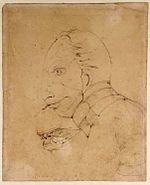 |
Ghost of a flea, head in profile | Blake drew the Ghost of a Flea twice in this book: once as a full body, and here, just its head in profile. |
 |
The Man who Built the Pyramids | Blake used this drawing to show his dislike for the very strict, mathematical way the Egyptians built things. The drawing shows the man with thick lips. A smaller drawing next to it might be a mason's workshop. At the bottom, there's a book with ancient Egyptian symbols. |
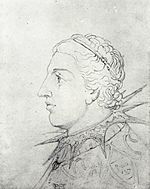 |
Edward VI? with a spiky collar | This drawing is thought to be a vision of a young prince from the royal family. The coat of arms on his shoulder shows the three lions of England. |
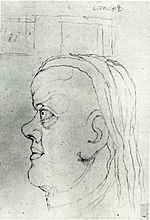 |
Cancer | This drawing is labeled by John Varley as Cancer, which is an astrological sign. However, some people think Blake might have drawn it as a funny picture of himself. |
The Large Blake–Varley Sketchbook

This sketchbook was sold in 1989. It's a larger album, about 254 × 203 mm. It contains over 60 of Blake's drawings. Some of the figures include:
- Canute
- Solomon
- Boadicea
- Merlin
- Owen Glendower
- Wat Tyler
- Alexander the Great
- Robin Hood
- Charlemagne
- John Milton (at different ages)
- Mary Queen of Scots
- William Shakespeare's Wife
- Socrates' wife, Xantippe
| Image | Title | Description |
|---|---|---|
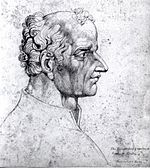 |
The Great Earl of Warwick Brother to Edward the 4th Drawn by Wm Blake | Richard Neville, 16th Earl of Warwick (1428—1471) was a powerful leader during the Wars of the Roses. He was so influential that he was called "Kingmaker" because he helped put two kings on the throne. |
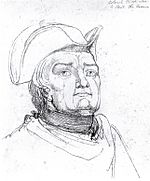 |
Colonel Blood who attempted to steal the Crown | Thomas Blood (1618—1680) was an adventurer famous for trying to steal the Crown Jewels of England from the Tower of London in 1671. Blake's drawing captures Blood's bold and daring personality. |
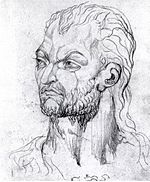 |
"Owen Glendower" | Owain Glyndŵr (around 1349/1359 — 1416) was a Welsh ruler and the last native Welshman to be called Prince of Wales. He led a rebellion against Henry IV of England to free the Welsh people. He is a Welsh national hero. |
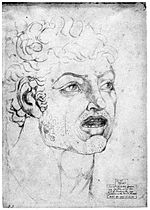 |
Wat Tyler by Wm Blake, from his spectre | This drawing is labeled by John Varley as "Wat / Tyler / By Wm Blake from / his Spectre as in the act of Striking the Tax / Gatherer on the head." Wat Tyler (1341—1381) was the leader of the 1381 Peasants' Revolt in England. He led protesters to London to oppose a new tax. |
The Folio Blake–Varley Sketchbook
This larger sketchbook has not been found completely. However, three loose pages with drawings of Pindar, Corinna, and Lais still exist. These images come from an album that was 42 × 27 cm.
| Image | Title | Description |
|---|---|---|
 |
Corinna the Rival of Pindar and Corinna the Grecian Poetess | These are two sketches of the same head, shown both from the front and in profile. Corinna was an ancient Greek poetess who was a teacher and rival to the famous poet Pindar. |
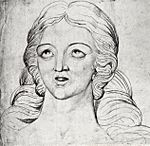 |
Visionary Head of Corinna The Theban – Detail 1 | Corinna (Greek: Κόριννα) was an ancient Greek poetess from Tanagra. She was known for winning poetry competitions against Pindar. |
 |
Visionary Head of Corinna The Theban – Detail 2 | It is said that Corinna defeated Pindar five times. Blake would have known these stories about her. |
Loose Visionary Heads
There are more than 50 individual drawings of visionary heads that were not part of the sketchbooks. Some of these include:
- Satan
- Lot
- Saul
- David
- Uriah and Bathsheba
- Job
- Nebuchadnezzar Coin
- Joseph and Mary
- Socrates
- Muhammad
- William Wallace and Edward I
- King Edward III
- Friar Bacon
- The spirit of Voltaire
- The Ghost of a Flea (tempera version)
- The Man Who Taught Blake Painting in his Dreams
| Image | Title | Description |
|---|---|---|
 |
Uriah the Husband of Bathsheba and Bathsheba | These two heads are drawn in profile for Varley and Linnell. |
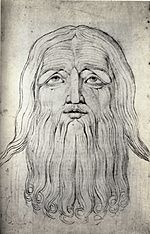 |
Head of Job | This detailed drawing was likely made for Blake's famous Illustrations of the Book of Job. It looks most like Job in one of the illustrations where he is looking up to heaven. |
 |
Joseph and Mary & the room They were seen in | These are carefully drawn images of a young Joseph and Mary, with their heads leaning towards each other. Mary's hands are crossed on her chest. Between their heads, there's a small drawing of "the room they were seen in" during Blake's vision. |
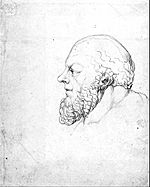 |
Socrates, a Visionary Head | Blake once said that he felt a connection to Socrates, as if they were "a sort of brother." He even said he had "conversations" with Socrates in his visions. |
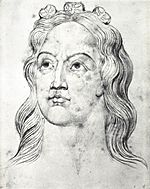 |
Queen Eleanor | This drawing is believed to be Eleanor of Aquitaine, the wife of Henry II of England and mother of Richard I. |
 |
The Assassin lying dead at the feet of Edward I & Saladin | This drawing shows two heads in profile. Above is a man lying on his back, labeled as "The Assassin." He tried to kill King Edward I during a crusade. Below is the head of Saladin, a powerful Sultan from the 12th century. |
 |
William Wallace & Edward Ist | The Scottish hero William Wallace (1270—1305) appeared to Blake, and then his enemy, Edward I (1272—1307), appeared. Blake recognized both of them right away. |
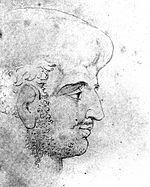 |
Visionary Head of Edward III? | Blake once wrote a play called "King Edward III." In his vision, the king seemed displeased and "bends the battlement of his brow upon you." |
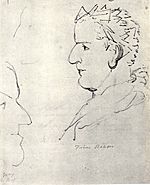 |
Gray the Poet & Friar Bacon | These are two visionary heads in profile. On the right is Roger Bacon (around 1214—1294), an English philosopher who believed in studying nature through experiments. On the left is Thomas Gray (1716—1771), an English poet famous for his "Elegy Written in a Country Churchyard." |
| Old Tom Parr when Young | Thomas Parr was an old countryman who was said to have lived to be 153 years old! This drawing shows him when he was young, around 40. | |
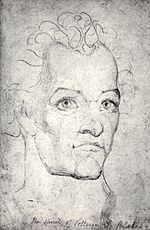 |
Spirit of Voltaire by Blake | The title for this drawing was written by John Varley. Blake had drawn Voltaire before and even quoted him in his writings. |
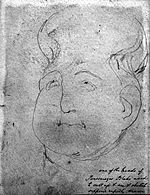 |
A Visionary Head | This drawing is one of the "sketches from personages as they appeared to him in Vision." Blake claimed he saw these people in his visions and drew them as he saw them. |
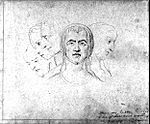 |
Five Visionary Heads of Women | These are heads Blake saw of "deceased worthies in vision." |
 |
Imagination of A man who Mr Blake has recd instruct[ion] in Painting &c from, counterproof | There are a few drawings about this same subject: "The Man Who Taught Blake Painting in his Dreams." |
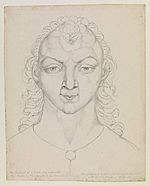 |
The Man Who Taught Blake Painting in his Dreams | This drawing is a copy of Blake's original, believed to be made by John Linnell. The detailed shape of the skull might be influenced by the study of phrenology, which was popular at the time. |
Images for kids
See also
- The Ghost of a Flea
Visionary Heads in Music
- Visionary Heads, five pieces for piano after pictures by William Blake Op. 172 (2013) written by Russian/British composer Dmitri N. Smirnov → YouTube



